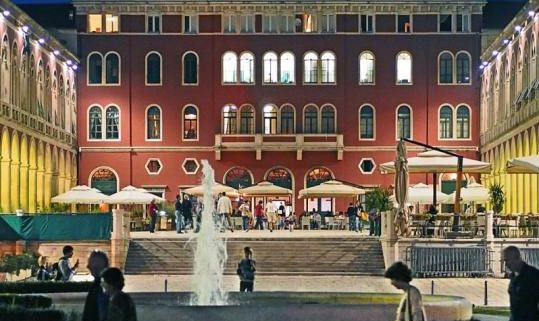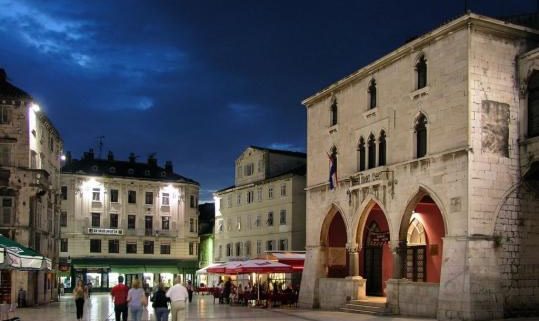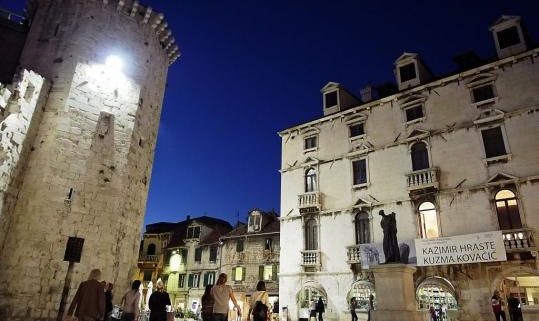City squares

Prokurative
Prokurative or as they are officially called, Republic Square resemble the Venice St. Marks Square. They are located west of the Riva and they were named after the arches found on the neo-Renaissance buildings surrounding the square on three sides. Most people to this day know it by that name. The square is only open on the south side, providing a beautiful view of the harbour and the Riva (waterfront). The building of the Prokurativa was initiated by one of the most renowned mayors in the history of the city Antonio Bajamonti in the mid 19th century. He wanted to show that Split supported Italian tradition with all its might. Hence the colonnade resembling Venetians, and reliefs above the windows evoking the ancient and Renaissance influences. Bajamonti also made his great theatre on the square, but it was destroyed by a fire.
The square has long been established as an excellent stage for cultural events, especially the pop music festival, and the local bars and restaurants made it a popular venue for the citizens of Split. The plateau on the south side has always been an integral part of Prokurative, with, ever since 1947, a neo-Classical fountain, destroyed by the communist authorities, due to its alleged connection to the Italian rule over Split and Dalmatia.


Pjaca
Pjaca (People’s Square, another square nobody in Split calls by its real name), is first mentioned in 13th century as St Lawrence’s Square, and it was the first inhabited part of Split outside the Diocletian Palace, leaning to its western wall. Already for centuries the Pjaca is the central stage of the city life, there in the Gothic building of the Old Town Hall, today an exhibition centre, was the seat of the city’s authority, and in still beautiful and preserved Palaces on the outskirts of the Pjaca lived the noble families Cambi, Pavlović, Nakić, Ciprianis, Karepić… Still open is one of the oldest book shops in the world, Morpurgo, to this day it looks almost the same as it looked in 1861, and in the Café Central where the intellectuals of Split gathered is where the tourism of Split begun with the former hotel Troccoli.
The city clock has been ticking for centuries on Pjaca, unique by his 24 instead of 12 digits, and in the surrounding cafés, restaurants and bars the citizens of Split could always find a place to rest, meet, be seen and see others, go through the most important events of the city. Every building on Pjaca has its story, each is a witness of history and the spirit of the city. As it was yesterday, it is also today, when Pjaca is filled with numerous bars, restaurants and shops, and when it became one of the most important spots for tourists wishing to enjoy in whatever it is that their hosts, citizens of Split, are enjoying.


Voćni trg (Fruit square)
Believe it or not, but this square, maybe the most beautiful one in the city, to the citizens of Split is more familiar under its unofficial rather than its official name of Trg Braće Radić (Square of the Radić brothers). Its “familiar” name comes from the fact that it was once home to the bustling and colourful market where women from the surrounding villages came to sell their fruit. On the neighbouring square, west of the Fruit Square, fruit was sold. There are several landmarks decorating this not so large a square thriving with city life in bars, restaurants and exclusive shops, a venue often used also by fairs. The biggest is certainly the octagonal Venetian tower, the leftover of the former fortress, built in the 15th century for the defence of, at the time, a small town. Opposite the tower is a magnificent Palace of the old family Milesi from the 17th century with a spectacular Baroque facade, one of the best examples of that style in the whole of Dalmatia. Just in front of it stands the monument to the father of the Croatian literature, the citizen of Split, Marko Marulić, who was one of the most important philosophers and intellectuals of the 15th century. The author of the monument, as well as of several others in the city is Ivan Meštrović. This is, of course, not all, as every stone on the Fruit Square, just like on the other old city squares , bears witness to the history and tells the story of the times that passed, from the oldest of days, “represented” by the south-western tower of the Diocletian Palace on the very exit from the Fruit Square to the Riva. Consequently, just like Pjaca, the Fruit Square has a special place in the heart of the citizens of Split, and all because it was the central location for the filming of one of the most popular Croatian TV series’, saga’s of Split “Velo Misto”.


 English
English Hrvatski
Hrvatski Deutsch
Deutsch Italiano
Italiano



